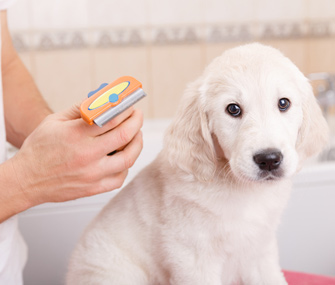Help! Our Puppy Hates to Be Brushed!
Published on April 04, 2017
Skip To

Our friendly, happy puppy hates having his fur brushed — he will run and hide when he sees the brush come out. What can we do to get him used to being groomed?
Dogs tend to remember experiences that are painful, scary or otherwise upsetting, especially if the negative experience occurred in the formative puppyhood weeks. Running away when the brush emerges most likely indicates that your puppy is feeling fear, anxiety or stress connected to the experience of being brushed.Fortunately, it is possible to transform your dog’s response to the brush. The strategy is to pair brushing with positive and enjoyable experiences.
Your first step, though, is to ensure that your puppy’s dislike of brushing isn’t related to a physical condition. An infected ear or inflammation in the joints, for instance, may cause a dog to balk when handled on or near these sensitive areas. Start with a trip to the veterinarian to rule out any medical reasons for your dog’s behavior. Once he has a clean bill of health, it’s time to teach him to love being groomed.
Check Your Equipment
Your dog may bolt from the brush because grooming is uncomfortable or even downright painful. Start by assessing the brush you are using; make sure that it’s not pulling your dog’s coat or hurting his skin. Hard metal bristles may pull your dog’s fur, while bristles that have lost their protective ends may be poking into his skin.Switching the type of grooming tools and products you are using may improve or even resolve this problem. A soft, flexible detangling brush and a dog-specific detangling product (used as needed) can go a long way toward reducing your puppy’s discomfort and easing his trepidation.
It’s also possible that the issue is not with your brush but rather with the way you are brushing. Instead of yanking or ripping through a knot or mat, gently work out tangles. If you encounter a stubborn knot, gently hold the fur just below the knotted area with one hand to help prevent pulling at the skin. Starting at the edge of the mat or knot, slowly work toward the center of the tangle. You should be able to gently tease the mat or knot apart without pulling your dog’s fur. In tough cases, a groomer may need to assist in working through or cutting out established mats. Regular brushing and grooming maintenance can help to keep your puppy’s coat tangle-free.
Make Brushing Fun
Before you jump into actually brushing your puppy, he may need some time to get used to the sight of the brush itself and to learn to associate the sight of it with good things happening. Place the brush on the ground and surround it with treats — you can even lay a few on the brush itself. Supervise your puppy while he investigates the brush. You can also feed your pup a tasty treat from a bowl placed next to the brush.Once he is comfortable with the sight of the brush, progress to sitting on the floor while holding the brush stationary in your hand. Allow your dog to approach at his own pace. Avoid moving the brush toward your dog; instead, reward any interest your puppy shows in the brush, even if it’s just a look.
Next, work on teaching your dog to remain in place for brief handling. Comfort is key to increasing handling tolerance. Brushing, like all handling, should only progress while your dog remains in place without struggling. Initially, you may need to offer a continuous stream of treats to help keep him in place. You may want to enlist a family member to help with treat delivery while you handle the brushing.
Start out by brushing gently for just a few seconds in an area where your dog is already willing to tolerate touch, such as his chest or shoulder. Gradually move to brushing other parts of his body or brushing for slightly longer before rewarding him. If he displays any signs of resistance or fear, back up and return to brushing for less time or only in areas he’s okay with.
A slow, gradual approach works best. Start with short sessions of brushing and offer ample treats and praise. Eventually, your puppy should learn to see brushing as a good thing.
More on Vetstreet:





